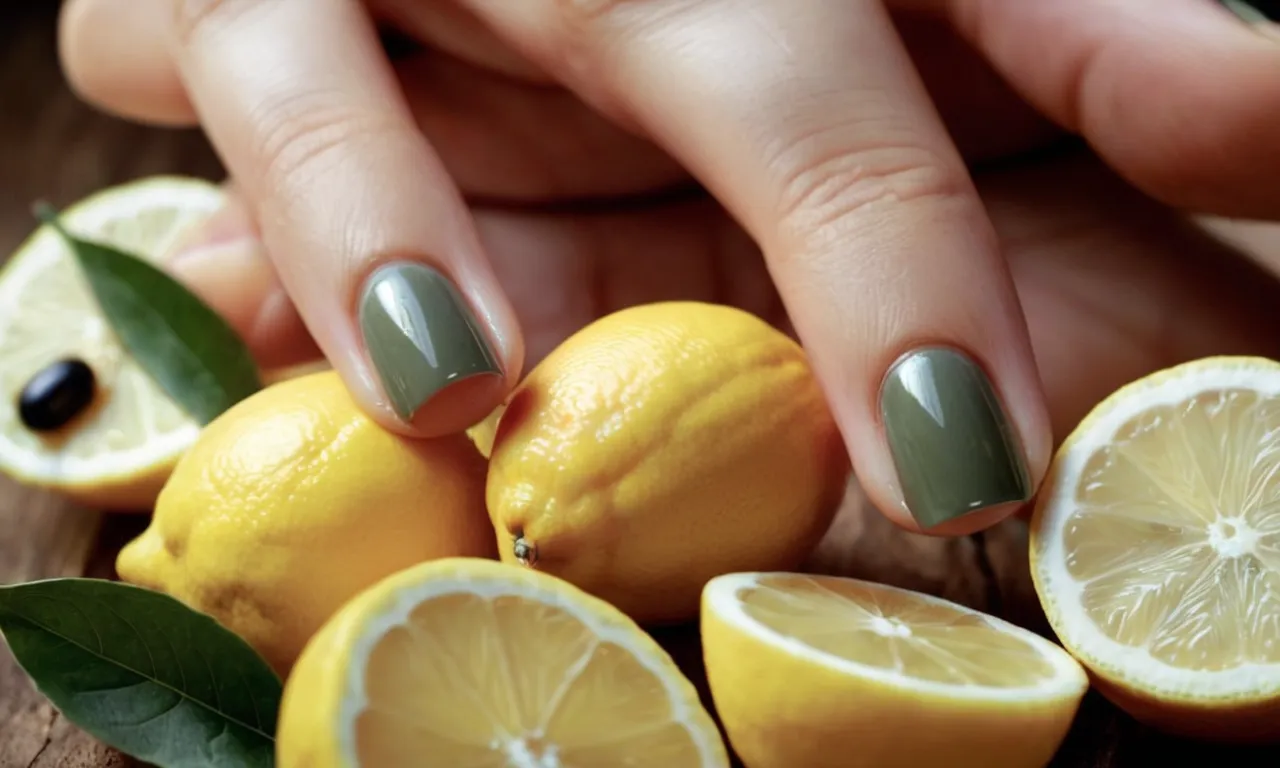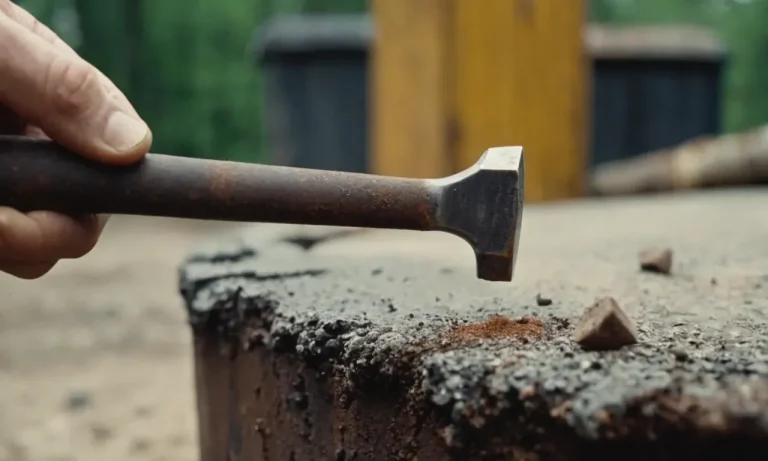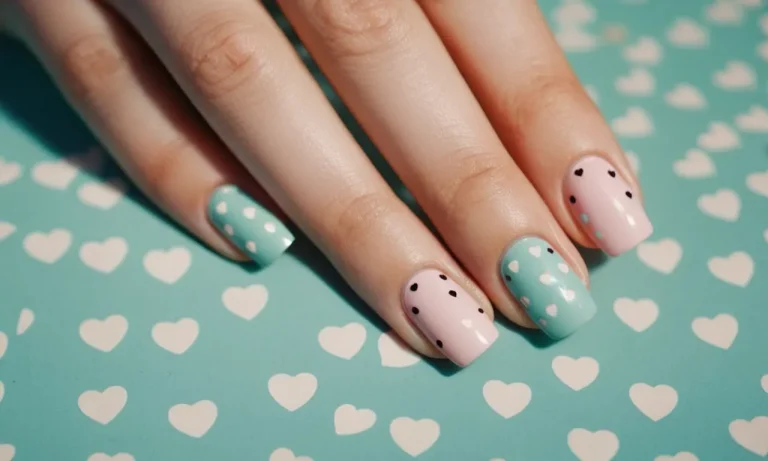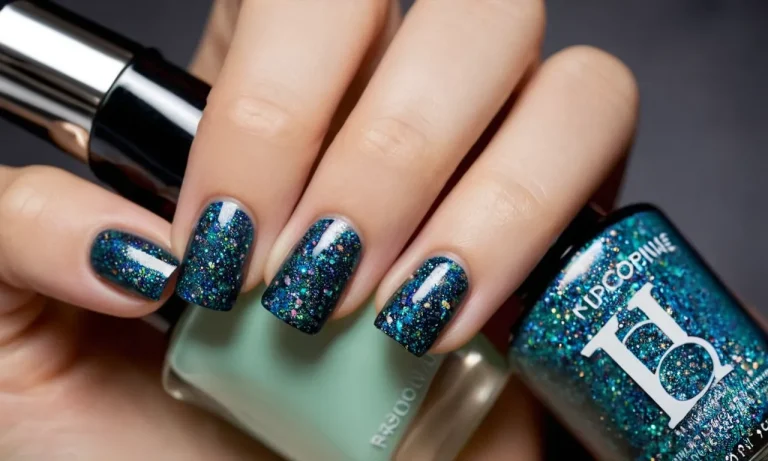How To Repair Damaged Nails At Home: 10 Easy Remedies
If you’re short on time, here’s a quick answer to your question: Keep nails trimmed and filed, use cuticle oil, apply nail strengtheners, avoid picking and peeling, massage with oils, soak in olive oil, use tea tree oil, apply coconut oil, try nail hardeners, and get enough vitamins and minerals.
Damaged nails can be an unsightly nuisance. Cracks, peeling, breakage and dryness can leave your nails looking unhealthy. While severe nail damage may require medical treatment, most nail issues can be repaired at home using simple ingredients you likely already have in your kitchen.
This article will provide a comprehensive guide on how to strengthen weak nails and repair various types of nail damage using natural home remedies. Read on to learn 10 easy DIY ways to fix broken, peeling and cracked nails and restore them to a healthy condition.
Keep Nails Trimmed and Filed
Keeping your nails neatly trimmed and filed is an important part of nail care and maintenance. Overly long nails are more prone to snagging, breaking, and splitting. Filing helps smooth rough edges and prevent hangnails.
By regularly trimming and filing your nails, you can help strengthen them and promote healthy growth.
Trim Nails Straight Across
Use nail clippers or scissors to trim your nails straight across, following the natural shape of your fingers. Avoid rounding the edges or cutting them too short, as this can lead to ingrown nails. The best time to trim your nails is right after bathing, when they are soft and pliable.
File in One Direction
Use a nail file to gently smooth roughness and shape your nails. Always file in one direction, moving from the outside edge toward the center of the nail. File gently and avoid sawing back and forth aggressively. This can weaken nails over time. Focus filing on snags and peeling edges.
Don’t Over-file Natural Nails
Be careful not to over-file or thin out natural nails too much. As you file, pay attention to any discomfort, heat, or nail surface changes, which can indicate too much filing pressure. If your nails become painful, stop filing. Over-filing can lead to nail damage over time.
Moisturize Cuticles and Nails
Keep cuticles and nails hydrated with cuticle oil or moisturizing creams. Apply them gently around the nail and cuticles daily. This softens cuticles, prevents hangnails, and promotes flexibility and strength.
Avoid Damaging Nails
Be gentle with your nails and avoid nicking, puncturing, or tearing them. Use care when doing household chores and consider wearing gloves. Limit use of nail polish remover, avoid very hot water, and pat hands dry to prevent excessive moisture.
See a Professional Regularly
Consider seeing a nail technician every few weeks for deep conditioning and professional shape and tips. Ask them to demonstrate proper at-home care as well.
By making nail trimming and filing part of your self-care routine, you can help your nails stay healthy and minimize the need for repairs. Pay attention for signs of damage and address them promptly by adjusting your at-home nail care.
Apply Cuticle Oil
Applying cuticle oil is one of the easiest and most effective home remedies for repairing damaged nails. Cuticle oil moisturizes the skin around the nails, known as the cuticles, as well as the nails themselves. This helps strengthen weak, brittle nails and can also help nails grow faster.
How Cuticle Oil Helps Repair Nails
Cuticle oil is infused with nutrients like vitamin E, vitamin A, and essential fatty acids. These nutrients sink into the nail bed and cuticles, restoring moisture. This moisture is crucial for healthy nail growth and strength.
Without proper moisture, nails become dry and brittle. Brittle nails peel, crack, split, and break more easily. They may also become discolored and dull.
Some research also suggests that massaging cuticle oil into the nail beds and cuticles improves circulation in the area. Better blood flow brings more nutrients to support strong nail regrowth.
Choosing a Good Cuticle Oil
Look for a cuticle oil formulated specifically for nail care when possible. Many body oils and lotions simply hydrate skin and do little to improve nail health.
Some key ingredients to look for include:
- Jojoba oil
- Vitamin E
- Wheat germ oil
- Tea tree oil
- Lavender oil
You can find cuticle oils with these ingredients online or from beauty supply stores fairly easily. Prices range from about $5 to $15 on average.
How to Apply Cuticle Oil for Nail Repair
Applying cuticle oil takes just a few minutes each day:
- Wash and dry your hands thoroughly.
- Apply a few drops of oil to each nail bed.
- Gently massage the oil into the nail beds and cuticles using small circular motions.
- Allow the oil to soak in for about 10 minutes before rinsing.
- Apply once or twice per day for best results.
After a week or two of daily use, you should notice visible improvements. Nails should start to look stronger and feel less brittle. Continued use helps support nail growth.
For additional benefits, apply a thick layer of oil before bed and allow it to soak in overnight. Consider wearing cotton gloves overnight as well to lock in moisture.
Be patient, as it can take several weeks to see significant changes in severely damaged nails. But with regular use of cuticle oil and good nail care habits, you can repair peeling, cracking, splitting nails relatively fast.
Use Nail Strengtheners and Hardening Polishes
Using nail strengtheners and hardening polishes is one of the best ways to repair damaged nails at home. These products work by providing extra layers of protection and moisture to weak, brittle nails.
How Nail Strengtheners Work
Nail strengtheners typically contain active ingredients like calcium, vitamins, and proteins that help to reinforce the nail plate. When applied regularly underneath polish, these strengtheners fill in cracks and gaps in the nails, acting like a fortifying base coat.
Some of the most common active ingredients in strengtheners include:
- Calcium – Provides structural support
- Biotin – Promotes keratin production for strong, flexible nails
- Hydrolyzed wheat protein – Seals the nail plate to prevent cracking and peeling
- Vitamins C and E – Powerful antioxidants that repair damage
Using a nail strengthener 2-3 times per week will help to noticeably improve the appearance and strength of nails within 4-6 weeks. For best results, apply directly to clean, dry nails and let dry completely before applying polish.
The Benefits of Hardening Nail Polishes
Whereas strengtheners work underneath color, hardening polishes fortify nails while providing glossy color. Many contain formaldehyde or formaldehyde resin, which forms dense cross-linkages between nail proteins to create a hard, protective layer.
Hardening polishes offer advantages like:
- Reinforce nails and increase resistance to splitting and peeling
- Quick-drying formulas allow multiple coats for added strength
- Durable, chip-resistant finish
- Hide imperfections in damaged nails
Experts recommend looking for formaldehyde-free options and applying a maximum of 2 coats. Removing hardening polish can dry out nails, so use acetone-free remover and follow up with a hydrating oil.
Tips for Using Nail Strengtheners and Hardening Polishes
To maximize the benefits of these products:
- Always prep nails by removing any polish, cleaning well with soap and water, and buffing gently to remove surface debris.
- Apply products to completely bare nails so active ingredients can fully penetrate.
- With strengtheners, wait until completely dry before adding polish.
- Stay diligent! It takes 4-8 weeks to see noticeable improvement in nail strength.
- Strengtheners and hardeners work best together as a system when used alternately.
- Take occasional breaks from polish – let nails “breathe” once a week if possible.
Damaged nails won’t improve overnight, but with consistent use of nail repair products, you can restore strength, luster and beauty to your nails. For severe cases, you may need specialized medical treatment, but for most people, at-home remedies and diligent care will reveal dramatic results over time.
Avoid Picking and Peeling Nails
Picking and peeling at your nails can be tempting when you have hangnails or chipped nail polish, but it’s important to avoid this bad habit. Not only can picking and peeling damage your nails even further, it can also lead to infection.
How Picking and Peeling Damages Nails
When you pick or peel at your nails, you are pulling layers of the nail plate away from the nail bed below. This can cause the nail to become thinner and weaker over time. Repeated picking and peeling can also damage the skin around the nails, leading to painful hangnails or even open wounds that are prone to infection.
Increase Infection Risk
As you peel layers of your nail, you create small openings in the nail plate that allow bacteria and fungi to more easily enter and infect the area under and around the nails. One study found that people who pick their nails are more likely to have fungal nail infections.
Tips to Stop Picking and Peeling
- Use a glass file to smooth rough edges rather than picking at them
- Keep nails neatly trimmed to minimize temptation
- Wear gloves for tasks where nails often catch or tear
- Apply a bitter-tasting deterrent polish to discourage nibbling
- Identify triggers and keep hands occupied another way
Kicking the habit of nail picking takes time and patience. If you slip up, don’t beat yourself up – just re-commit to stopping. With diligence, you can undo damage done from past picking and have beautiful, healthy nails again. 💅
Massage Nails and Cuticles with Oils
Massaging your nails and cuticles with oils is an easy and effective way to repair damaged nails at home. Here are some tips on how to rejuvenate your nails through massage:
Choose a Nourishing Oil
Pick an oil that is rich in nutrients to deeply moisturize your nails and cuticles. Great options include:
- Jojoba oil – Contains vitamins E and B that strengthen nails.
- Coconut oil – Has anti-fungal and antibacterial properties to treat infections.
- Olive oil – Softens cuticles and conditions nails.
- Almond oil – Loaded with vitamin E, proteins, and minerals.
- Avocado oil – Deeply hydrates and repairs dry, brittle nails.
Directions
Follow these steps to massage your nails with oil:
- Apply a few drops of oil onto each nail and cuticle.
- Gently rub the oil into your nails using circular motions.
- Push back and massage your cuticles to stimulate blood circulation.
- Leave the oil on for at least 10 minutes before rinsing.
- Repeat daily or several times a week.
Other Tips
- Soak nails in oil weekly for an intensive treatment.
- Use an old toothbrush to gently exfoliate nails and remove dead cuticle skin.
- Apply thicker oils like castor oil to damaged nails and cover with cotton gloves overnight.
- Avoid over-soaking nails to prevent moisture imbalance.
- Keep cuticles moisturized with oil to prevent painful cracking and hangnails.
The massage action helps oil penetrate deeper into the nail bed for enhanced conditioning. The oils provide essential hydration and nutrients to strengthen weak, brittle nails. With regular oil massages, you can have healthy, growing nails naturally.
Soak Nails in Olive Oil
Olive oil is an amazing home remedy for strengthening weak and brittle nails. Its nourishing fatty acids like oleic acid help condition nails and cuticles, making them more flexible and less prone to breakage or peeling.
Soaking nails in olive oil is an easy DIY treatment that can dramatically improve nail health.
How It Works
Olive oil contains antioxidants like vitamins E and K which protect nails from free radical damage. It also has antibacterial and antifungal properties to fight infections. The rich fatty acids penetrate deep into the nail bed, softening dry, cracked cuticles and conditioning the nail plates.
This rehydrates brittle nails, making them more flexible and less likely to split or tear. Regular olive oil soaks can also stimulate healthy new nail growth, helping to treat issues like peeling layers or ridges on nails.
Method
Soaking nails in olive oil is simple:
- Warm up a small bowl of extra virgin olive oil to a comfortable temperature.
- Submerge nails in the bowl for 10-15 minutes.
- Gently massage oil into nails and cuticles.
- Rinse off with warm water and pat dry.
Aim to do this treatment several times per week until you see an improvement in nail health. The warming allows deeper penetration while the massage boosts circulation for better results.
| Olive Oil Soak Benefits |
|---|
| ➢ Hydrates dry, brittle nails |
| ➢ Softens and conditions cuticles |
| ➢ Reduces splitting and peeling |
| ➢ Strengthens thin or weak nails |
| ➢ Stimulates healthy new nail growth |
Tips for Best Results
To get the most out of olive oil nail soaks:
- Choose extra virgin olive oil for maximum nourishment
- Warm the oil to open pores for better absorption
- Exfoliate nails first to remove dead cells and debris
- Use freshly washed hands for a thorough treatment
- Apply a moisturizer after to seal in the oils
While olive oil is generally very nourishing for nails, those with sensitive skin may experience contact dermatitis. Test on a small patch first before wider application.
For severely damaged nails, combine olive oil soaks with a biotin supplement or nail strengthener containing hydrolyzed wheat protein.
Apply Tea Tree Oil
Tea tree oil is a popular natural remedy that can help strengthen nails and treat damage. It has powerful antifungal and antibacterial properties that help fight infections that can cause nail problems. Here’s how to use it:
What is Tea Tree Oil?
Tea tree oil, also known as melaleuca oil, is an essential oil extracted from the leaves of the Melaleuca alternifolia plant. It contains compounds like terpinen-4-ol that give it strong antimicrobial effects (1).
This makes it useful for treating fungal and bacterial infections on the skin and nails.
How Does it Help Damaged Nails?
Using tea tree oil can help damaged nails in a few ways:
- Kills fungus and bacteria – This helps treat infections like onychomycosis that can cause nail damage.
- Reduces inflammation – The anti-inflammatory effects help reduce redness and swelling.
- Moisturizes nails – It helps condition nails and cuticles to improve appearance.
- Prevents future infections – It creates an antiseptic layer that protects against microbes.
How to Use Tea Tree Oil for Nails
Here are some simple ways to use tea tree oil on your nails:
- Add 5-10 drops of tea tree oil to 1 tablespoon of carrier oil like coconut oil. Apply this mixture to nails and cuticles 2-3 times per day.
- Add 2-3 drops of tea tree oil to your regular nail polish. Shake well and apply to nails as usual.
- Mix 5 drops of tea tree oil with 1 teaspoon of apple cider vinegar. Soak nails in this solution for 10-15 minutes daily.
- Put 1-2 drops of undiluted tea tree oil directly on discolored or damaged nails using a cotton swab.
It’s best to always mix tea tree oil with a carrier oil or dilute it before applying topically. Using it undiluted may cause irritation in some people.
Other Benefits of Tea Tree Oil
In addition to strengthening nails, tea tree oil provides other benefits including:
- Treating acne and skin infections
- Soothing insect bites and sting sites
- Alleviating cold sores
- Reducing dandruff and lice
- Easing respiratory conditions like bronchitis
It’s an extremely versatile natural remedy that’s useful to have at home. Just be sure to do a patch test before widespread use to check for allergic reactions.
Precautions When Using Tea Tree Oil
While generally safe for most people, here are some precautions to take with tea tree oil (2):
- Always dilute it before applying to skin.
- Avoid use if pregnant or breastfeeding.
- Keep away from eyes, inner nose, and sensitive areas.
- Don’t swallow it.
- Do a patch test on a small area of skin first.
- Stop use if irritation develops.
Using tea tree oil appropriately can help naturally treat damaged nails and improve their appearance. Along with other remedies, it can get your nails looking healthy again.
Use Coconut Oil
Coconut oil is a natural moisturizer that can help repair damaged nails and cuticles. Here are some tips for using coconut oil on your nails:
Soften Cuticles
Rub a small amount of coconut oil into your cuticles and nail beds every night before bed. The moisturizing properties will help condition the skin and prevent hangnails.
Treat Split Nails
If you have split nails, dab coconut oil onto the split part and massage it in. This will hydrate the nail and help bond the layers back together.
Strengthen Brittle Nails
Make a homemade nail treatment by mixing 1 tablespoon of coconut oil with 2-3 drops of lemon juice. Apply this mixture to your nails and let it soak in for 10-15 minutes before rinsing. The coconut oil will strengthen and the lemon will help build keratin.
Heal Damaged Nail Beds
For nails damaged by injury or infection, rub coconut oil into the nail bed 2-3 times per day. This will promote healing through its antibacterial and moisturizing properties.
Prevent Hangnails
Rub coconut oil around the edges of your nails every day to keep the skin hydrated. This prevents painful hangnails from forming.
DIY Cuticle Cream
Whip up your own intensive cuticle repair treatment by mixing 1 teaspoon coconut oil with 1/2 teaspoon honey and 1 drop of lemon essential oil. Apply this to your cuticles before bed and cover hands with cotton gloves overnight.
Coconut oil is affordable, easy to find, and simple to use. With regular application, it can transform even the most damaged nails. For best results, use coconut oil as part of your daily nail care routine.
Try Nail Hardeners
If your nails seem thin, brittle or weak, using a nail hardener can help strengthen them and prevent further damage. Nail hardeners work by providing a protective layer over the natural nail that reinforces it. There are several excellent nail hardeners available to help repair damaged nails at home.
How Do Nail Hardeners Work?
Nail hardeners typically contain active ingredients like calcium, keratin, silk or formaldehyde. When applied to the nails regularly, these ingredients bond with the nail plate to create a rigid, protective coating that makes nails less prone to splitting, peeling or breaking.
Some of the most popular nail hardening ingredients include:
- Formaldehyde – chemically bonds with keratin in the nails
- Calcium – provides minerals to strengthen weak spots
- Keratin – mimics the natural protein structure of nails
- Silk or soy proteins – reinforce the nail plate for added flexibility
Choosing an Effective Nail Hardener
Look for products containing calcium, keratin, silk, soy or horsetail extract for fortifying effects. Ingredients like biotin and green tea may also help strengthen nails. Products labeled “nail hardener” or “strengthening polish” are good options.
Some top-rated nail hardeners include:
- Sally Hansen Hard as Nails
- Onyx Hard As Hoof Nail Strengthening Cream
- Barielle Nail Strengthener Cream
- Orly Nailtrition
Avoid formaldehyde-based hardeners if you have brittle nails or sensitivities. Seek formaldehyde-free formulas instead.
How to Use Nail Hardeners
Apply nail hardener to clean, dry nails every few days. Put on 1-2 thin coats, allowing each layer to dry completely before adding the next. Using too much can make nails rigid and inflexible over time.
For best results, commit to using a nail hardener consistently for 6-8 weeks so the strengthening ingredients have time to fully penetrate and fortify nails. Continued occasional use can maintain improvements.
Look for change in nail texture and appearance within a few weeks. Nails should start feeling stronger and less prone to splitting or peeling. If you don’t see a difference after 2 months, try a different product.
Additional Tips for Improving Nail Strength
While nail hardeners repair existing damage, taking proactive steps protects nails from breaking down further:
- Wear rubber gloves for wet work to avoid over-exposure
- Use cuticle oil daily to condition the nail bed
- Avoid excessive filing or buffing, which thins nails
- Trim nails straight across to prevent cracks or tears
- Take biotin supplements to boost nail health from within
Be patient, as it takes time for nails to regenerate. Within about 6 months, diligent care can transform even the most damaged nails. If issues persist, check with a dermatologist to address potential underlying causes.
Get Enough Vitamins and Minerals
Getting adequate vitamins and minerals is crucial for strong, healthy nails. Some key nutrients include:
Biotin
Biotin is a B vitamin that plays an important role in the health of hair, skin, and nails. Studies show that taking 2.5 mg of biotin per day can significantly improve the thickness and hardness of nails in people with brittle nails.[1]
Food sources of biotin include eggs, organ meats, cauliflower, mushrooms, and nuts. However, getting enough from diet alone can be challenging for some people. Supplements are widely available and generally well tolerated.
Vitamin C
Vitamin C aids collagen production, which forms the foundation for strong nails. One study in people with brittle nails found that taking vitamin C supplements for 6 months increased nail thickness by 25%.[2]
Citrus fruits, bell peppers, broccoli, strawberries, and kiwi are excellent sources of vitamin C. For those struggling to get enough from foods, supplements are readily available.
Iron
Iron is essential for nails, as it carries oxygen to nail beds. Low iron levels have been linked to spoon-shaped nails that are concave.
The best sources of iron are red meat, poultry, seafood, beans, lentils, spinach, and iron-fortified grains. For those with iron deficiency, supplements may be recommended under medical supervision.
Zinc
Zinc is needed for many aspects of cellular metabolism and nail growth. Deficiency has been associated with white spots in fingernails.
Foods high in zinc include oysters, beef, chicken, pumpkin seeds, lentils, yogurt, and chickpeas. Supplements are another option if you are struggling to get enough zinc from diet.
Silica
Silica is a trace mineral needed for nail strength and flexibility. Horsetail plant extracts are a concentrated source of silica that may help brittle nails when taken regularly.
Food sources of silica include oats, rice, millet, beans, asparagus, cucumbers, and bell peppers. However, it’s difficult to get therapeutic doses from diet alone.
Selenium
Selenium helps regulate thyroid hormones and protect cell membranes. Low levels have been linked to white spots on nails.
Brazil nuts, tuna, eggs, mushrooms, and sunflower seeds are rich in selenium. People who are deficient may benefit from supplements.
Conclusion
Damaged nails can occur for a variety of reasons, from minor trauma to nutritional deficiencies. While medical treatment may be needed in some cases, many common nail problems can be repaired at home using simple natural ingredients.
By keeping nails trimmed and filed, using oils and creams to moisturize nails and cuticles, avoiding picking and peeling, applying nail hardening products, and getting proper nutrition, you can strengthen weak nails and restore their health and appearance.
With a little time and TLC using these handy home remedies, your nails will look their best in no time.







